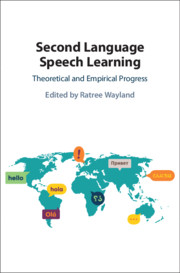Book contents
- Second Language Speech Learning
- Second Language Speech Learning
- Copyright page
- Dedication
- Contents
- Figures
- Tables
- Contributors
- Preface
- Acknowledgments
- Part I Theoretical Progress
- Part II Segmental Acquisition
- Part III Acquiring Suprasegmental Features
- Part IV Accentedness and Acoustic Features
- Chapter 13 Comparing Segmental and Prosodic Contributions to Speech Accent
- Chapter 14 Do Proficient Mandarin Speakers of English Exhibit an Interlanguage–Speech Intelligibility Benefit When Tested with Complex Sound–Meaning Mapping Tasks?
- Chapter 15 Foreign Accent in L2 Japanese
- Part V Cognitive and Psychological Variables
- Index
- References
Chapter 15 - Foreign Accent in L2 Japanese
Cross-Sectional Study
from Part IV - Accentedness and Acoustic Features
Published online by Cambridge University Press: 21 January 2021
- Second Language Speech Learning
- Second Language Speech Learning
- Copyright page
- Dedication
- Contents
- Figures
- Tables
- Contributors
- Preface
- Acknowledgments
- Part I Theoretical Progress
- Part II Segmental Acquisition
- Part III Acquiring Suprasegmental Features
- Part IV Accentedness and Acoustic Features
- Chapter 13 Comparing Segmental and Prosodic Contributions to Speech Accent
- Chapter 14 Do Proficient Mandarin Speakers of English Exhibit an Interlanguage–Speech Intelligibility Benefit When Tested with Complex Sound–Meaning Mapping Tasks?
- Chapter 15 Foreign Accent in L2 Japanese
- Part V Cognitive and Psychological Variables
- Index
- References
Summary
Accents in second language speech have multiple perceptual consequences, including breakdown in communication and undesirable judgements about accented speakers. Whereas perceived accents are likely influenced by various acoustic variables, it is not clear which acoustic variables influence the perceived accents the most and whether such important predictors of accents change as learners’ proficiency develops. Here we report a study that has examined acoustic sources of foreign accent in second language Japanese produced by American learners at different instructional levels, including beginning and intermediate late learners and early bilinguals. We collected speech samples from these learners as well as a control group of native speakers, and measured 27 segmental and prosodic variables. These acoustic variables were related to accent rating scores obtained from native listeners. Confirmatory analyses showed that 24 out of 27 variables tested were reliably associated with listeners’ accentedness judgements. Exploratory analyses showed that prosodic features were most predictive of beginning to intermediate late learners’ accents, whereas vowel features were most predictive of early bilinguals’ accents. These results shed light on issues related to the acoustic sources of foreign accent and the development of second language speech.
- Type
- Chapter
- Information
- Second Language Speech LearningTheoretical and Empirical Progress, pp. 377 - 396Publisher: Cambridge University PressPrint publication year: 2021
References
- 2
- Cited by

